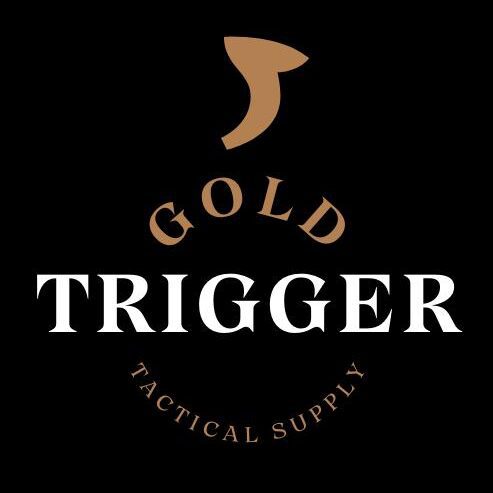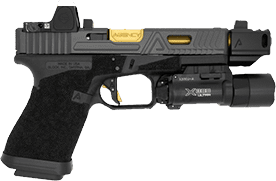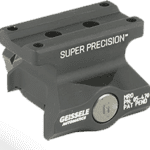Emissary Development Mini Handbrake: Compact Design Review
Published on: September 23, 2025

Reading time: 6 mins 16 secs
Emissary Development’s Mini Handbrake (both in M-LOK and Picatinny) is a smaller version of their full-size Handbrake. The company says it keeps the same forward-swept angle and texture while weighing about 0.8 oz (22 g) – 1 oz (28 g).
Many compact handstops on the market trade features for small size. Emissary’s Mini is marketed to keep key features while cutting bulk.
This review will look at how its design choices work in the real world and when a compact handbrake is an advantage for your build.
Highlights
- The Emissary Mini Handbrake weighs only 0.8 – 1 oz for true lightweight performance.
- Its compact design saves valuable rail space in tight builds.
- The Mini keeps the same forward-swept ergonomics as the standard version.
- Heat resistance exceeds 300°F for reliable use under stress.
- Steel M-LOK hardware ensures secure and long-term mounting.
Mini Handbrake vs. Standard: Engineering a Smaller Footprint
Size Optimization Without Performance Loss
The Mini was designed to keep handstop function while cutting bulk. The M-LOK version measures 1.9″ long, 1.1″ wide, and 1.5″ tall.
The Picatinny version only differs in width and height—they’re 1.4” and 1.7” respectively.
By comparison, the standard Handbrake keeps the same length and width but has a taller profile, so the Mini reduces overall height. This smaller profile helps when you need less obstruction around the rail.
The Mini weighs about 0.8 – 1 oz, which is unusually light for a functional handstop. That small weight can surprise shooters used to heavier polymer or aluminum options.
Both the Mini and the standard Handbrake use a 1.5-slot M-LOK mounting footprint (6 for Picatinny). That means the Mini saves space by lowering its external profile rather than by using fewer attachment points.
Because it keeps the same mounting span while reducing height, the Mini is a smart choice when you need extra clearance near optics, lights, or other accessories.
Performance Retention in Compact Form
Emissary says the Mini keeps the same forward-swept angle as the full-size Handbrake. That angle is intended to help index your support hand into a consistent position.
Many users and reviewers report that the forward sweep helps maintain control and smooth target transitions. You’ll usually notice the same natural hand placement the full-size model encourages.
The Mini uses Emissary’s proprietary texture pattern on its smaller surface. The company and customers say the texture still gives aggressive purchase and good control in most practical shooting scenarios.
The Mini also keeps an anti-slip bottom ledge. Users report that it reduces forward hand slippage during fast target changes or stressful drills, even though the part is smaller.
What’s Preserved vs. What’s Optimized
The Mini keeps the same forward-swept angle, texture pattern, and barricade stop layout as the full-size Handbrake. These elements are unchanged and provide a familiar feel if you’ve used the standard version.
Emissary designed the Mini by trimming excess material while keeping the part structurally solid. Even with its lighter build, most shooters describe it as durable and secure in use.
The trade-off comes with hand placement. Its smaller footprint can give shooters with larger hands fewer grip options, but most adapt quickly after some time on the range.
Compact Design Applications: When Smaller Wins
Short-Barreled Rifle Optimization
If you run an SBR (Short-Barreled Rifle), the Mini’s reduced profile saves rail space and avoids crowding on short handguards. That extra room matters when mounting lights, lasers, or controls.
Short barrels change heat dynamics, so parts see more thermal stress. The Mini’s 300°F+ heat resistance helps it hold up during higher rates of fire.
Balance also becomes critical on compact rifles. At just around 0.8 – 1 oz, the Mini keeps front weight down, so added accessories don’t throw off handling.
AR Pistol and Compliance Considerations
AR pistol builds need careful attention to federal rules about overall length and accessories. Follow regulations and check your full configuration before assuming compliance.
The Mini’s small size gives you more installation flexibility, but whether your build is legal depends on barrel length, overall length, and how you use any stabilizing brace. Don’t assume a compact part alone guarantees compliance.
A lower-profile handbrake is less likely to physically interfere with a stabilizing brace or its adjustment.
Many users say the streamlined design helps one-handed control without adding bulk that gets in the way. That practical benefit is experience-based, so test it on the range for your specific setup.
Competition and Training Applications
Lighter accessories help you move faster on staged courses, so every gram counts during timed events. Reducing mass on your rifle can shave small but meaningful time off transitions.
A compact handbrake stows more easily in race bags and transport cases. That low profile makes switching between rifle setups less of a hassle.
Low-profile stops also help with barricade work. You can get the muzzle and support hand closer to cover without parts snagging or getting in the way.
Space-Limited Rail Configurations
Modern builds often need lights, lasers, pressure switches, and backup sights on a small amount of rail real estate. A compact handbrake frees up external space so you can place more essential accessories.
Smaller handstops make cable routing and pressure-switch management simpler. With fewer bulky parts in the way, you can run cleaner, less snag-prone wiring.
A reduced profile also lowers the risk of interfering with flip-up sights and magnifiers. Still, always test the clearance with your specific optics and sight setup before you finalize placement.
Real-World Performance Analysis
Controlled Testing Comparisons
Emissary says the Mini keeps the same grip geometry and texture as the standard Handbrake. Many users and reviewers report similar grip consistency in live fire.
Both versions use the same indexing angle and lower ledge, and shooters often find comparable support-hand stability in different positions. The Mini’s smaller profile usually gives you more clearance around obstacles.
Reviewers commonly report no practical difference in rapid-fire control between the Mini and the full-size model. The forward-swept shape still helps manage recoil even with the reduced dimensions.
Users also say barricade work feels about the same, while the Mini lets you move in a little closer to cover. That extra clearance can help when you need to avoid snagging or interference.
Material Performance Under Stress
The Mini is made from glass-filled nylon that’s rated to handle high heat. It’s designed to hold up under repeated use without warping or degrading.
Both versions share the same textured surface pattern. Users say the grip remains solid even after long training sessions.
Emissary includes steel M-LOK hardware with both models. The fasteners use the same torque specs, so you get secure and reliable mounting over time.
Installation and Integration Strategies
Step 1: Prepare Your Firearm
Make sure your firearm is fully unloaded and pointed in a safe direction.
Step 2: Determine Hand Placement
Identify where your support hand naturally rests. A common starting point is about one-third down the handguard from the receiver.
Step 3: Plan Accessory Layout
Before mounting, map out lights, lasers, and switches. This ensures the Mini doesn’t interfere with your other gear.
Step 4: Check Clearance
Account for nearby optics, magnifiers, and backup sights. The compact footprint makes clearance planning easier in tight builds.
Step 5: Install with Correct Torque
Follow standard M-LOK specs for polymer parts—15 inch-pounds. Use a quality torque wrench to avoid stripping or damaging hardware.
Step 6: Integrate with Controls
Mount the Mini in a way that supports cable routing for pressure pads. Its smaller size leaves more room for tidy cable management.
Step 7: Verify Functionality
Cycle through shooting positions and manipulate accessories. Confirm that the Mini works seamlessly with lights, lasers, and sight systems.
Market Position Assessment
At around $32 – $37, the Mini offers professional-grade materials and proven design at a competitive retail price.
It competes against compact handstops that typically sacrifice features for size reduction. Most alternatives use simplified designs or inferior materials to achieve smaller dimensions.
Weight comparisons favor the Mini’s precise 22-gram specification against aluminum alternatives that often weigh more while providing similar surface area. The engineering efficiency becomes apparent in direct measurements.
Feature retention sets the Mini apart from budget options significantly. You get professional-grade materials and proven design rather than simplified alternatives that compromise on essential characteristics.
Conclusion
The Emissary Mini Handbrake keeps the Handbrake’s core geometry and features in a much smaller package. Many users and reviewers say it delivers comparable real-world performance to the full-size model.
Because it uses the same forward-swept angle and texture pattern, the Mini aims to preserve ergonomics and control while cutting bulk. If you want to keep professional-grade materials without extra mass, it’s a strong option.
Whether you’re building an accessory-heavy duty rifle or a speed-focused competition gun, the Mini helps you save space and weight without sacrificing core function. Browse our Emissary selection or call (713) 485-5773 for help picking the right setup.
Disclaimer: The information provided in this comprehensive Emissary Development Mini Handbrake review is for educational and informational purposes only. Firearm accessories and modifications can affect weapon safety, performance, and legal compliance. Users are solely responsible for ensuring all modifications and purchases comply with applicable federal, state, and local laws before installation or use.
Improper installation of firearm accessories can result in serious injury, equipment damage, or dangerous malfunction. We strongly recommend professional installation by qualified gunsmiths for all firearm modifications and accessories. This guide does not substitute for manufacturer instructions, proper training, or professional expertise.
Legal requirements vary significantly by jurisdiction. Some states and localities restrict certain firearm modifications, accessories, or configurations, particularly regarding short-barreled rifles (SBRs) and AR-style pistols. Always verify compliance with ATF regulations and your local laws before purchasing or installing any tactical accessories. When in doubt, consult with legal professionals specializing in firearms law.
Product specifications, availability, pricing, and legal requirements are subject to change without notice. Always verify current information with Emissary Development, authorized dealers, and relevant legal authorities before making purchasing decisions. This information reflects current market conditions and may not apply to future product availability or regulatory changes.
Gold Trigger is not responsible for any modifications, installations, or purchases made based on this information. Users assume all risks associated with firearm accessory use, including but not limited to personal injury, equipment damage, legal liability, and performance variations. Always prioritize safety, legal compliance, and proper training over performance modifications.





Comments